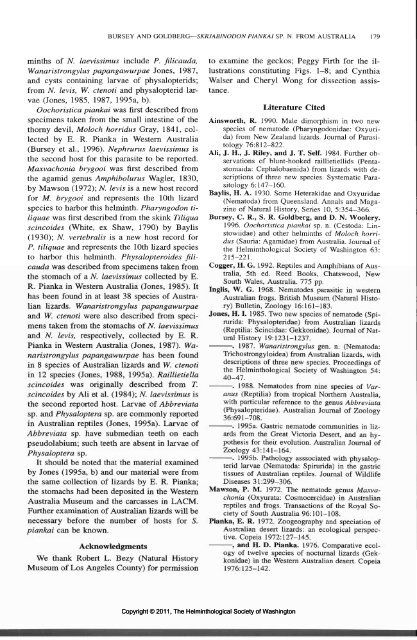The Helminthological Society of Washington - Peru State College
The Helminthological Society of Washington - Peru State College
The Helminthological Society of Washington - Peru State College
Create successful ePaper yourself
Turn your PDF publications into a flip-book with our unique Google optimized e-Paper software.
BURSEY AND GOLDBERG—SKRJAB1NODON PIANKAI SP. N. FROM AUSTRALIA 179<br />
minths <strong>of</strong> N. laevissimus include P. filicauda,<br />
Wanaristrongylus papangawurpae Jones, 1987,<br />
and cysts containing larvae <strong>of</strong> physalopterids;<br />
from N. levis, W. ctenoti and physalopterid larvae<br />
(Jones, 1985, 1987, 1995a, b).<br />
Oochoristica piankai was first described from<br />
specimens taken from the small intestine <strong>of</strong> the<br />
thorny devil, Moloch horridus Gray, 1841, collected<br />
by E. R. Pianka in Western Australia<br />
(Bursey et al., 1996). Nephrurus laevissimus is<br />
the second host for this parasite to be reported.<br />
Maxvachonia brygooi was first described from<br />
the agamid genus Amphibolurus Wagler, 1830,<br />
by Mawson (1972); N. levis is a new host record<br />
for M. brygooi and represents the 10th lizard<br />
species to harbor this helminth. Pharyngodon tiliquae<br />
was first described from the skink Tiliqua<br />
scincoides (White, ex Shaw, 1790) by Baylis<br />
(1930); N. vertebralis is a new host record for<br />
P. tiliquae and represents the 10th lizard species<br />
to harbor this helminth. Physalopteroides filicauda<br />
was described from specimens taken from<br />
the stomach <strong>of</strong> a N. laevissimus collected by E.<br />
R. Pianka in Western Australia (Jones, 1985). It<br />
has been found in at least 38 species <strong>of</strong> Australian<br />
lizards. Wanaristrongylus papangawurpae<br />
and W. ctenoti were also described from specimens<br />
taken from the stomachs <strong>of</strong> N. laevissimus<br />
and N. levis, respectively, collected by E. R.<br />
Pianka in Western Australia (Jones, 1987). Wanaristrongylus<br />
papangawurpae has been found<br />
in 8 species <strong>of</strong> Australian lizards and W. ctenoti<br />
in 12 species (Jones, 1988, 1995a). Raillietiella<br />
scincoides was originally described from T.<br />
scincoides by Ali et al. (1984); N. laevissimus is<br />
the second reported host. Larvae <strong>of</strong> Abbreviata<br />
sp. and Physaloptera sp. are commonly reported<br />
in Australian reptiles (Jones, 1995a). Larvae <strong>of</strong><br />
Abbreviata sp. have submedian teeth on each<br />
pseudolabium; such teeth are absent in larvae <strong>of</strong><br />
Physaloptera sp.<br />
It should be noted that the material examined<br />
by Jones (1995a, b) and our material were from<br />
the same collection <strong>of</strong> lizards by E. R. Pianka;<br />
the stomachs had been deposited in the Western<br />
Australia Museum and the carcasses in LACM.<br />
Further examination <strong>of</strong> Australian lizards will be<br />
necessary before the number <strong>of</strong> hosts for S.<br />
piankai can be known.<br />
Acknowledgments<br />
We thank Robert L. Bezy (Natural History<br />
Museum <strong>of</strong> Los Angeles County) for permission<br />
to examine the geckos; Peggy Firth for the illustrations<br />
constituting Figs. 1-8; and Cynthia<br />
Walser and Cheryl Wong for dissection assistance.<br />
Literature Cited<br />
Ainsworth, R. 1990. Male dimorphism in two new<br />
species <strong>of</strong> nematode (Pharyngodonidae: Oxyurida)<br />
from New Zealand lizards. Journal <strong>of</strong> Parasitology<br />
76:812-822.<br />
Ali, J. H., J. Riley, and J. T. Self. 1984. Further observations<br />
<strong>of</strong> blunt-hooked raillietiellids (Pentastomaida:<br />
Cephalobaenida) from lizards with descriptions<br />
<strong>of</strong> three new species. Systematic Parasitology<br />
6:147-160.<br />
Baylis, H. A. 1930. Some Heterakidae and Oxyuridae<br />
(Nematoda) from Queensland. Annals and Magazine<br />
<strong>of</strong> Natural History, Series 10, 5:354-366.<br />
Bursey, C. R., S. R. Goldberg, and D. N. Woolery.<br />
1996. Oochoristica piankai sp. n. (Cestoda: Linstowiidae)<br />
and other helminths <strong>of</strong> Moloch horridus<br />
(Sauria: Agamidae) from Australia. Journal <strong>of</strong><br />
the <strong>Helminthological</strong> <strong>Society</strong> <strong>of</strong> <strong>Washington</strong> 63:<br />
215-221.<br />
Cogger, H. G. 1992. Reptiles and Amphibians <strong>of</strong> Australia,<br />
5th ed. Reed Books, Chatswood, New<br />
South Wales, Australia. 775 pp.<br />
Inglis, W. G. 1968. Nematodes parasitic in western<br />
Australian frogs. British Museum (Natural History)<br />
Bulletin, Zoology 16:161-183.<br />
Jones, H. I. 1985. Two new species <strong>of</strong> nematode (Spirurida:<br />
Physalopteridae) from Australian lizards<br />
(Reptilia: Scincidae: Gekkonidae). Journal <strong>of</strong> Natural<br />
History 19:1231-1237.<br />
. 1987. Wanaristrongylus gen. n. (Nematoda:<br />
Trichostrongyloidea) from Australian lizards, with<br />
descriptions <strong>of</strong> three new species. Proceedings <strong>of</strong><br />
the <strong>Helminthological</strong> <strong>Society</strong> <strong>of</strong> <strong>Washington</strong> 54:<br />
40-47.<br />
. 1988. Nematodes from nine species <strong>of</strong> Varanus<br />
(Reptilia) from tropical Northern Australia,<br />
with particular reference to the genus Abbreviata<br />
(Physalopteridae). Australian Journal <strong>of</strong> Zoology<br />
36:691-708.<br />
. 1995a. Gastric nematode communities in lizards<br />
from the Great Victoria Desert, and an hypothesis<br />
for their evolution. Australian Journal <strong>of</strong><br />
Zoology 43:141-164.<br />
-. 1995b. Pathology asssociated with physalopterid<br />
larvae (Nematoda: Spirurida) in the gastric<br />
tissues <strong>of</strong> Australian reptiles. Journal <strong>of</strong> Wildlife<br />
Diseases 31:299-306.<br />
Mawson, P. M. 1972. <strong>The</strong> nematode genus Maxvachonia<br />
(Oxyurata: Cosmocercidae) in Australian<br />
reptiles and frogs. Transactions <strong>of</strong> the Royal <strong>Society</strong><br />
<strong>of</strong> South Australia 96:101-108.<br />
Pianka, E. R. 1972. Zoogeography and speciation <strong>of</strong><br />
Australian desert lizards: an ecological perspective.<br />
Copeia 1972:127-145.<br />
, and H. D. Pianka. 1976. Comparative ecology<br />
<strong>of</strong> twelve species <strong>of</strong> nocturnal lizards (Gekkonidae)<br />
in the Western Australian desert. Copeia<br />
1976:125-142.<br />
Copyright © 2011, <strong>The</strong> <strong>Helminthological</strong> <strong>Society</strong> <strong>of</strong> <strong>Washington</strong>
















